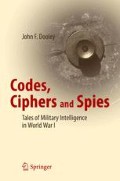Abstract
This article, number IX, is similar to and possibly a continuation of Manly’s Article VIII. It deals with mostly civilian letters in uncommon foreign languages and with hoaxes that people attempted to perpetrate on their friends. Other letters included chess moves, music annotations, contest entries, surveyor’s notes, and, the largest group of all, enciphered love letters. Obviously, during war the postal censorship office would intercept any encrypted letter and forward it on to MI-8. The interesting point here is that most of these letters are entirely innocent, either jokes or encrypted for lovers’ privacy.
Access this chapter
Tax calculation will be finalised at checkout
Purchases are for personal use only
Notes
- 1.
There were all different German ciphers. See Childs (1919). For example, Alachi was a double transposition cipher.
- 2.
This is James Henry Breasted (1865–1935), at the time director of the Oriental Institute and the Haskell Oriental Museum at the University of Chicago.
- 3.
The Litany of the Saints is a prayer in the Roman Catholic Church, along with other denominations that are close in liturgy to the Catholics (like the Anglican Church). It consists of several prayers, all of which are supplications, to the three parts of the Triune God and to a list of the saints. It is most typically sung at Easter. See http://en.wikipedia.org/wiki/Litany_of_the_Saints (accessed August 13, 2014).
- 4.
New York Point is a raised-letter system for the blind like Braille. It was invented by William Bell Wait, a teacher at the New York Institute for the Education of the Blind. Because it was more cumbersome to use than English and American Braille, it eventually lost support. See http://en.wikipedia.org/wiki/New_York_Point (accessed August 13, 2014).
- 5.
The tonic sol-fa system is a way of teaching sight singing invented by Sarah Ann Glover of Norwich, England. It is a solfège that uses pronounceable syllables to teach pitch and sight-reading. The English syllable equivalents are do, re, mi, fa, so, la, and ti. See http://en.wikipedia.org/wiki/Tonic_sol-fa (accessed August 13, 2014).
- 6.
The best-known amulets worn by Catholics are crucifixes, medals (e.g., St. Christopher medals), and scapulars.
- 7.
The cryptogram appears to be a mixed alphabet monoalphabetic substitution cipher. Its single letter frequency chart is very close to that of regular German plain text. The decryption is left as an exercise for the interested reader.
Reference
Childs, J. Rives. 1919. The History and Principles of German Military Ciphers, 1914–1918. Paris: United States Army Expeditionary Force. Friedman Collection. National Archives, College Park, MD.
Author information
Authors and Affiliations
Rights and permissions
Copyright information
© 2016 Springer International Publishing Switzerland
About this chapter
Cite this chapter
Dooley, J.F. (2016). Civilian Correspondence: Foreign Letters and Hoaxes. In: Codes, Ciphers and Spies. Copernicus, Cham. https://doi.org/10.1007/978-3-319-29415-5_10
Download citation
DOI: https://doi.org/10.1007/978-3-319-29415-5_10
Published:
Publisher Name: Copernicus, Cham
Print ISBN: 978-3-319-29414-8
Online ISBN: 978-3-319-29415-5
eBook Packages: HistoryHistory (R0)

